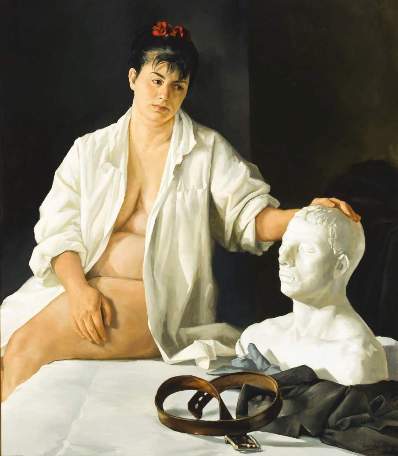Dido and Aeneas
Peter Churcher

Details
- Artist
- Peter Churcher
- Title
- Dido and Aeneas
- Year
- 1999
- Medium
- oil on canvas
- Size
- 122 x 107cm
- Details
signed lower right: P. Churcher '99
- Stock Number
- 260247
Sold This artwork has been sold. Please contact us for similar artworks.
Provenance
the artist
Lauraine Diggins Fine Art, Melbourne, 1999
private collection, Melbourne
Exhibited
Peter Churcher, Lauraine Diggins Fine Art, Melbourne, 8 -29 May 1999, no.9
Annual Collectors' Exhibition 2008, Lauraine Diggins Fine Art, Melbourne, 1 Oct- 8 Nov 2008, cat. no. 60
Further Information
Dido and Aeneas belongs to an important series of paintings by Peter Churcher from the late 1990s which were inspired by ancient myths and legends. The painting is based the legend of Queen Dido, the founder and ruler of Carthage (in present-day Tunisia), as told by Virgil in the the Trojan War epic, Aeneid. Abandoned by her lover, Prince Aeneas, a Trojan hero and the legendary founder of Rome, the Queen orders a funerary pyre to be erected, where she intends to burn all the relics that remind her of Aeneas, but ultimately perishes herself within the conflagration.
The legend inspired numerous artists over the centuries, including Rubens, Tiepolo, Reni and Reynolds. Churcher does not quote directly from the Old Masters. As Sasha Grishin observed, "Churcher is a very visually literate artist, one who from childhood has been extensively exposed to the 'grand tradition' of western art.... His process of painting also involves something of an intellectual game... Direct quotations from other paintings are fairly sparse, only occasionally there is a reference to a specific identifiable source. Generally, it is like a dull echo a familiar leitmotif, a recognisable theme from a passage of music, which has been incorporated within a broader structure. The trappings of the allegorical reference are increasingly removed, so that it appears as if pithing a common everyday reality there are found echoes of the grandeur of the Old Masters."
(Grishin, S., Peter Churcher, Lauraine Diggins Fine Art, Melbourne, 2004)
Instead, the artist transports the ancient legend into the present day situation and turns it into a universal image of love and abandonment within the post-modern discourse."
E.Barilo von Reisberg, Annual Collectors' Exhibition 2008, Lauraine Diggins Fine Art, Melbourne, 2008, p.57
As the realisation of irrevocable separation sets in for poor Dido, she gathers together her lover Aeneas' clothes and an effigy of him, which she places on her funeral bed.
"On the pyre's top she put a sword he left
With clothing, and an effigy on a couch
Her mind fixed now ahead on what would come."
Virgil, The Aeneid Book IV
